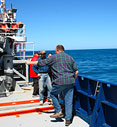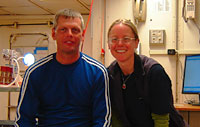

 | |||||||||||||||||
|
|
Journals 2008/2009Jeff Lawrence
December 31, 2008 This journey started many months ago. Dr. Balch began planning by writing proposals for grants to the NSF (National Science Foundation) and others many months ahead of the departure of the REVELLE form Montevideo's port on December 4. After the proposal was accepted and funding completed, a team of international scientists regularly using Skype began to plan the best way of attack for finding and studying coccolithophore blooms off the Patagonian Shelf. Supplies and materials had to be shipped across the ocean days in advance to Tampa, Florida for storage aboard the REVELLE in late October, or directly to Montevideo, Uruguay. Permits to ship the materials across international borders were applied for, and granted. A lot of paper work helped to push the process along. Passports had to be updated, medical forms filled out, and an itinerary for the trip planned so all the forces could come together to get this study: "Factors Controlling Coccolithophore Calcification in the Ocean" off the ground and moving forward. After nearly five weeks we are nearing the end of our journey. More stations were completed than originally planned for, indicating great success in collecting samples and data for further analysis back at the home labs.
As we move closer to the Falkland Islands we have seen more birds. Now you will also see land birds approach the ship.
Today we had our final science meeting in the library. Final preparations are being made to secure all the samples and make sure they get shipped back to their home labs safely. We are finishing up the final stations today. A total of 152 CTD stations have now been completed and fieldwork is finished. There will be many months of work ahead as the samples are prepared back at the labs so scientists can glean the information that is stored on them from all around the Patagonian Shelf. The trip for gathering the information has been a success, with more stations added as the trip progressed. The ship and crew were able to get from station to station more efficiently than first thought. Weather played a minimal factor. Most of the trip the weather was good for this part of the world. However in the last two weeks as we approached and worked around the Falklands, the weather tended to be damper, colder, and the seas much rougher. There were only a few occasions where a CTD or other off board activity was cancelled due to weather. Science on the open seas is much like the mailman, we kept working in all kinds of weather and the REVELLE was an efficient vessel for getting us from station to station. The complete story of this study will take several years to understand. Scientist who were aboard are from all over the world and will meet several times to share and compare data collected before making the final study available for all to see. Science can be a slow methodical and deliberate process. Everyone wants to make sure that the facts are correct before presenting the results for the rest of the world to see.
Question of the Day:
|
||||||||||||||||



